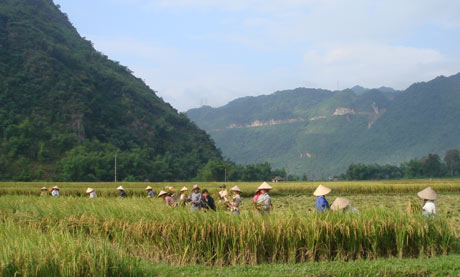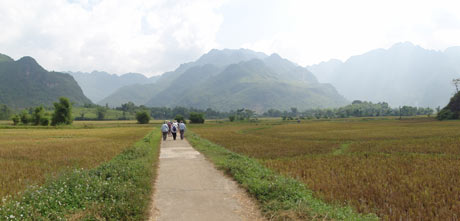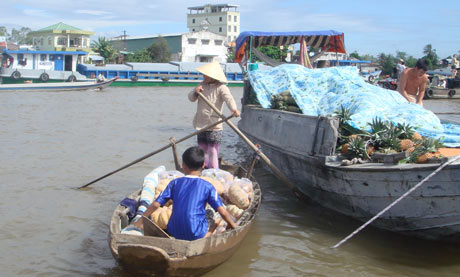Liz Boulter gets off the Vietnam tourist trail on a trip to meet the village women who make the country's crafts – and finds paradise for conscientious shoppers.
It started with a tiny ceramic teapot and that led to a
lacquered bamboo dish in a bright abstract pattern, then a hand-woven
scarf. It was just the start of my tour of Vietnam, and I was already hooked.
I am not usually a shopaholic, but here not only did the prices appeal to my Yorkshire sensibilities – none of the above items cost more than £2 – but I could convince myself that this retail therapy was doing some good. There's all sorts of tat on sale to tourists in Vietnam, much of it made in China. But I knew my spending would make a difference to local lives because I was on holiday with an organisation which makes that its mission.
Traidcraft, the people behind the British catalogues and gift shops, has teamed up with cycling-holiday operator Saddle Skedaddle (one of its founders used to work for Traidcraft) to offer trips to the developing countries the charity sources its wares from. The idea of Traidcraft's "Meet the People" holidays (there's no cycling on this particular trip) was to give people who were already part of the fair-trade movement – volunteering in shops, running stalls – the chance to see where products originated.
Even for those who've never been near a fairly traded fruit bowl, the tours offer a unique perspective, on people and cultures as well as sightseeing. (They also run trips in other Asian countries, and in Africa and Latin America.) Plus you get to shop till you drop, and feel good about it.
My teapot and dish came from a showroom in Hanoi run by Craft Link, a non-profit organisation that works with 60 artisan groups in northern Vietnam. Over tea and little cakes upstairs, we heard from manager Ms Tran and younger Ms Thuy all about its work finding markets for handicrafts as a way of keeping traditions alive and alleviating poverty. It's not charity: they help groups for a couple of years, with training and financial support. And they always work with women.
Then we were let loose in the shop: our group of 15 Brits snapped up silk purses and scarves, bags, ceramics and jewellery. There was still more than two weeks of the tour left, but hey, a gorgeous little brooch won't take up much room.

I am not usually a shopaholic, but here not only did the prices appeal to my Yorkshire sensibilities – none of the above items cost more than £2 – but I could convince myself that this retail therapy was doing some good. There's all sorts of tat on sale to tourists in Vietnam, much of it made in China. But I knew my spending would make a difference to local lives because I was on holiday with an organisation which makes that its mission.
Traidcraft, the people behind the British catalogues and gift shops, has teamed up with cycling-holiday operator Saddle Skedaddle (one of its founders used to work for Traidcraft) to offer trips to the developing countries the charity sources its wares from. The idea of Traidcraft's "Meet the People" holidays (there's no cycling on this particular trip) was to give people who were already part of the fair-trade movement – volunteering in shops, running stalls – the chance to see where products originated.
Even for those who've never been near a fairly traded fruit bowl, the tours offer a unique perspective, on people and cultures as well as sightseeing. (They also run trips in other Asian countries, and in Africa and Latin America.) Plus you get to shop till you drop, and feel good about it.
My teapot and dish came from a showroom in Hanoi run by Craft Link, a non-profit organisation that works with 60 artisan groups in northern Vietnam. Over tea and little cakes upstairs, we heard from manager Ms Tran and younger Ms Thuy all about its work finding markets for handicrafts as a way of keeping traditions alive and alleviating poverty. It's not charity: they help groups for a couple of years, with training and financial support. And they always work with women.
Then we were let loose in the shop: our group of 15 Brits snapped up silk purses and scarves, bags, ceramics and jewellery. There was still more than two weeks of the tour left, but hey, a gorgeous little brooch won't take up much room.

An boat trip to Halong Bay. Photograph: Liz Boulter
Next day, chatting on the bus as we left Hanoi for a trip upcountry,
Ms Thuy told me she's proudest of the effect Craft Link has on the role
of village women. Consider, she said, your average Vietnamese farmer:
he's been indulged from infancy (while his sisters worked hard) and
graduates to the local pastimes of wife-beating and drinking rice wine.
Though cash income is only about $100 a year, there's plenty to eat,
from the chickens, fishpond, rice paddies and vegetable garden. Then the
wife hears about these city people who'll pay good money for her
embroidery. And in no time she's spending her days sewing in a jolly
group with her friends, rather than weeding the paddies and massaging
his feet. And he can't complain, because she brought in nearly $400 last
year: it's paid for a TV, and he's hoping for a motorbike.
Ms Thuy once asked a hilltribe woman what had changed since she started selling handicrafts. "Now I can smile," she said, revealing a row of pretty teeth. Her own teeth had rotted when she was in her 20s, but her craft money had paid for a set of crowns.
Our destination was the Mai Chau valley – home to ethnic minority White Thai people – but we stopped first at Ha Thai village, which specialises in lacquered bamboo. A family group in one workshop were completing a US order for 3,000 bowls with an elegant painted stripe – they get 30% of the final price. We watched the age-old process of splitting bamboo, bending it, coiling it round a mould then sanding it before applying 15 coats of (food-safe) cashew-nut lacquer. Up the street, men and women were using beads and coconut shells to make colourful jewellery – ooh, yes, my daughter will like that bangle, with its white-on-black pattern.
Some in our group recognised these products from Traidcraft outlets back home and could talk about how well, say, a particular vase sells. That was what made this trip different: we were in tiny villages tourists would never normally see, not as strangers, but as part of the effort to bring prosperity to these communities. (All the more reason to take home one of those pretty coloured trays, too.)
The region of Mai Chau, 100km from Hanoi, is classic rural Vietnam: rice paddies stretching flat as a green fitted carpet to a ring of jagged mountains, with conical hats and water buffalo dotting the fields. This is where a lot of Craft Link's textiles are made. A friend's upcoming birthday made a good excuse to pick up a soft scarf in muted green and red. One loom on the edge of the village was being operated by a young and enterprising disabled woman: as we passed she gave chase in her wheelchair with a selection of her wares – and made a sale.

Ms Thuy once asked a hilltribe woman what had changed since she started selling handicrafts. "Now I can smile," she said, revealing a row of pretty teeth. Her own teeth had rotted when she was in her 20s, but her craft money had paid for a set of crowns.
Our destination was the Mai Chau valley – home to ethnic minority White Thai people – but we stopped first at Ha Thai village, which specialises in lacquered bamboo. A family group in one workshop were completing a US order for 3,000 bowls with an elegant painted stripe – they get 30% of the final price. We watched the age-old process of splitting bamboo, bending it, coiling it round a mould then sanding it before applying 15 coats of (food-safe) cashew-nut lacquer. Up the street, men and women were using beads and coconut shells to make colourful jewellery – ooh, yes, my daughter will like that bangle, with its white-on-black pattern.
Some in our group recognised these products from Traidcraft outlets back home and could talk about how well, say, a particular vase sells. That was what made this trip different: we were in tiny villages tourists would never normally see, not as strangers, but as part of the effort to bring prosperity to these communities. (All the more reason to take home one of those pretty coloured trays, too.)
The region of Mai Chau, 100km from Hanoi, is classic rural Vietnam: rice paddies stretching flat as a green fitted carpet to a ring of jagged mountains, with conical hats and water buffalo dotting the fields. This is where a lot of Craft Link's textiles are made. A friend's upcoming birthday made a good excuse to pick up a soft scarf in muted green and red. One loom on the edge of the village was being operated by a young and enterprising disabled woman: as we passed she gave chase in her wheelchair with a selection of her wares – and made a sale.

Mai Chau paddy fields. Photograph: Liz Boulter
Westerners are beginning to discover this area: there's one hotel in
Hoa Binh (Mai Chau Lodge, 33a Pham Ngu Lao Street, tel +84 4 3926 3125, maichaulodge.com)
and several families, particularly in Ban Lac village, have embraced
the homestay idea. We all stayed in a traditional house on stilts,
sleeping on mattresses on the slatted bamboo floor of the one upstairs
room – looking like so many incubating aliens inside our mosquito nets –
and feasting on home-produced fish, chicken, tofu, rice and vegetables.
On the other side of Hanoi, reached by a dyke road above flat fields in the Red river delta, lies Xuan Lai village. Here bamboo is smoked according to methods developed over centuries of living in bamboo homes: smoking darkens, strengthens and preserves. New bamboo lay soaking in ponds, where it stays for six months, before being moved to a kiln and smoked, turned daily for an even colour.
Word of our arrival had spread, and as we watched the dark bamboo being fashioned into chairs, tables, even beds, villagers started to arrive outside the workshop, on foot or bike, some carrying babies, to view the foreigners. The family's grandmother smiled happily at us, even though her teeth were completely black from chewing betel nut, which strengthens as it blackens – or so I was told. Alas, there was nothing here small enough to add to my stash – though the sturdy furniture goes down a storm, particularly in the States.
The trip wasn't all remote villages and worthy projects. We did the Hanoi sights, made an overnight trip to Halong Bay, then headed south to the old imperial capital, Hue, with its river, palace and pagoda (where I bought a silk shirt for about £6).
Just outside the city, Thuy Xuan village specialises in two traditional products. I watched as, with her baby crawling around, a woman ironed dried bamboo leaf, then carefully sewed it layer by layer onto a bamboo frame to make a conical hat. Each takes her half a day – and they were selling for $3. I hoped their other line was more lucrative: this is one of the few places in Vietnam where incense is still made by hand, in a long process involving drying, chopping and powdering cinnamon and sandalwood.
I looked pretty stupid in the hat, but little handmade sticks that would make east London smell like old Vietnam? Couldn't say no.
Tourists flock to Hoi An, with its ancient riverside houses, cooking schools and nearby beach. Positioned to attract many of them, with a shop on the main drag, was one of the cheeriest places we visited in this generally smiley land. Reaching Out is fair-trade gift shop with, opening on to the river behind, an airy workshop where disabled artisans were making a too-tempting array of goodies: screen-printed silks, ceramics with delicate filigree trim, embroidered bags, greeting cards and fabric toys.

On the other side of Hanoi, reached by a dyke road above flat fields in the Red river delta, lies Xuan Lai village. Here bamboo is smoked according to methods developed over centuries of living in bamboo homes: smoking darkens, strengthens and preserves. New bamboo lay soaking in ponds, where it stays for six months, before being moved to a kiln and smoked, turned daily for an even colour.
Word of our arrival had spread, and as we watched the dark bamboo being fashioned into chairs, tables, even beds, villagers started to arrive outside the workshop, on foot or bike, some carrying babies, to view the foreigners. The family's grandmother smiled happily at us, even though her teeth were completely black from chewing betel nut, which strengthens as it blackens – or so I was told. Alas, there was nothing here small enough to add to my stash – though the sturdy furniture goes down a storm, particularly in the States.
The trip wasn't all remote villages and worthy projects. We did the Hanoi sights, made an overnight trip to Halong Bay, then headed south to the old imperial capital, Hue, with its river, palace and pagoda (where I bought a silk shirt for about £6).
Just outside the city, Thuy Xuan village specialises in two traditional products. I watched as, with her baby crawling around, a woman ironed dried bamboo leaf, then carefully sewed it layer by layer onto a bamboo frame to make a conical hat. Each takes her half a day – and they were selling for $3. I hoped their other line was more lucrative: this is one of the few places in Vietnam where incense is still made by hand, in a long process involving drying, chopping and powdering cinnamon and sandalwood.
I looked pretty stupid in the hat, but little handmade sticks that would make east London smell like old Vietnam? Couldn't say no.
Tourists flock to Hoi An, with its ancient riverside houses, cooking schools and nearby beach. Positioned to attract many of them, with a shop on the main drag, was one of the cheeriest places we visited in this generally smiley land. Reaching Out is fair-trade gift shop with, opening on to the river behind, an airy workshop where disabled artisans were making a too-tempting array of goodies: screen-printed silks, ceramics with delicate filigree trim, embroidered bags, greeting cards and fabric toys.

Walking through paddy fields in a village in the Mai Chau region
Telling myself I mustn't buy another teapot, I settled for silk
pyjamas for my small nieces and a couple of miniature folding lanterns
made from split bamboo and offcuts of printed cotton (great Christmas
decorations). Dung, making the lanterns, told me how Reaching Out has
given him work, a future, even a social life. We're in touch by email:
him telling me about his wedding, me sending snaps of London.
There was mainstream fun in the following days at the resort of Nha Trang: swimming and snorkelling on the coral reef off protected Hon Mun island, and a hilarious mud bath at Thap Ba hot springs. But most tourists can do that if they choose. Not many also get to head inland to Cam Lam district to meet the crochet ladies.
Two more redoubtable women, Ms Khanh and Ms My, have been running Ho Chi Minh city-based Mai Handicrafts for more than two decades, originally as a way of helping street kids. In Cam Duc village, with its big Catholic church, there was no handicraft tradition, so Mai Handicrafts helped women form a crochet group. Now 18 of them work at producing dolls, mobile phone covers, hair ornaments – and a cute little ladybird tape-measure that I just had to have.
Lynette from Teesside dug from her bag a photograph of a Traidcraft stall in her home town – showing crocheted Christmas tree ornaments made in this very village, on sale 9,000 miles away in our chilly north-east.
One family, the Chins, had crocheted themselves a two-storey house, with pillared veranda and fitted kitchen – OK, not literally, but with money earned through Traidcraft they'd sent their son to university. His well-paid job had paid for a new family house. Beneath a picture of Our Lady of Perpetual Succour, identical to one that hung in my convent school at home, we were plied with tea and mounds of home-grown fruit (fantastic dipped in salt and chilli). "They like visitors," said My. "Village life is quite dull."
The feelgood shopping continued as we headed south. Ho Chi Minh City offered temples, markets, the Reunification Palace, the War Museum – and an ethical business on the outskirts, where I fell for an unusual Christmas crib set made from glued strips of waste paper. The brown and fertile Mekong delta brought another remote homestay, sampan and cycling trips, the Cai Rang floating market – and table mats woven from bamboo leaf and strips of newspaper by genial ladies of 77 and 80 with the deftest fingers I've ever seen. I bought coffee, tea, sweets, a pair of mango-wood salad servers …

There was mainstream fun in the following days at the resort of Nha Trang: swimming and snorkelling on the coral reef off protected Hon Mun island, and a hilarious mud bath at Thap Ba hot springs. But most tourists can do that if they choose. Not many also get to head inland to Cam Lam district to meet the crochet ladies.
Two more redoubtable women, Ms Khanh and Ms My, have been running Ho Chi Minh city-based Mai Handicrafts for more than two decades, originally as a way of helping street kids. In Cam Duc village, with its big Catholic church, there was no handicraft tradition, so Mai Handicrafts helped women form a crochet group. Now 18 of them work at producing dolls, mobile phone covers, hair ornaments – and a cute little ladybird tape-measure that I just had to have.
Lynette from Teesside dug from her bag a photograph of a Traidcraft stall in her home town – showing crocheted Christmas tree ornaments made in this very village, on sale 9,000 miles away in our chilly north-east.
One family, the Chins, had crocheted themselves a two-storey house, with pillared veranda and fitted kitchen – OK, not literally, but with money earned through Traidcraft they'd sent their son to university. His well-paid job had paid for a new family house. Beneath a picture of Our Lady of Perpetual Succour, identical to one that hung in my convent school at home, we were plied with tea and mounds of home-grown fruit (fantastic dipped in salt and chilli). "They like visitors," said My. "Village life is quite dull."
The feelgood shopping continued as we headed south. Ho Chi Minh City offered temples, markets, the Reunification Palace, the War Museum – and an ethical business on the outskirts, where I fell for an unusual Christmas crib set made from glued strips of waste paper. The brown and fertile Mekong delta brought another remote homestay, sampan and cycling trips, the Cai Rang floating market – and table mats woven from bamboo leaf and strips of newspaper by genial ladies of 77 and 80 with the deftest fingers I've ever seen. I bought coffee, tea, sweets, a pair of mango-wood salad servers …

A floating market. Photograph: Liz Boulter
My said: "It's good to show that some westerners care about better lives for Vietnamese people, not just exploiting them."
I care, I do. And a percentage of the price of the holidays goes to the producer groups. But, gleefully surveying my booty as I got ready to fly home, I realised I had shown my care so much I was going to have to jettison some of my clothes to fit it all in.
I care, I do. And a percentage of the price of the holidays goes to the producer groups. But, gleefully surveying my booty as I got ready to fly home, I realised I had shown my care so much I was going to have to jettison some of my clothes to fit it all in.





0 nhận xét:
Post a Comment